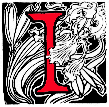 n a letter that Wilde's editors assign to April 1891, he clearly and unequivocally states the doctrine of art of art's sake, several times inadvertently revealing the essential incoherence and lack of intellectual rigor in the notion (one really can't call it a theory). He begins by telling one R. Clegg, whom the editors have been unable to identify, that “Art is useless because its aim is simply to create a mood. It is not meant to instruct, or to influence action in any way.” Wilde makes clear that he does not believe true art can function didactically, but if it “simply” creates a mood, it obviously has an effect as well as an affect, and it is not clear how art, which is not a thinking, feeling entity, can be for its own sake.
n a letter that Wilde's editors assign to April 1891, he clearly and unequivocally states the doctrine of art of art's sake, several times inadvertently revealing the essential incoherence and lack of intellectual rigor in the notion (one really can't call it a theory). He begins by telling one R. Clegg, whom the editors have been unable to identify, that “Art is useless because its aim is simply to create a mood. It is not meant to instruct, or to influence action in any way.” Wilde makes clear that he does not believe true art can function didactically, but if it “simply” creates a mood, it obviously has an effect as well as an affect, and it is not clear how art, which is not a thinking, feeling entity, can be for its own sake.
Wilde continues: “It is superbly sterile, and the note of its pleasure is its sterility.” Wilde, as in so much of his writing, here follows John Ruskin, who argued against both didactic art and the commonplace eighteenth-century theory that beauty in art and nature derive from utility. Wilde characteristically continues by asserting that “if the contemplation of a work of art is followed by activity of any kind, the work is either of a very second-rate order, or the spectator has failed to realise the complete artistic impression” (478). Again, one can see that Wilde does not want to function as propaganda or indoctrination, but given that, according to him, art creates a mood, it cannot be sterile, superbly or otherwise.
The sloganeering continues when Wilde adds in his second and last paragraph that “A work of art is useless as a flower is useless. A flower blossoms for its own joy. We gain a moment of joy by looking at it. That is all that is to be said about our relations to flowers. Of course man may sell the flower, and so make it useful to him, but this has nothing to do with the flower. It is not part of its essence. It is accidental, It is a misuse. All this is very obscure. But the subject is a long one” (478-79). Yes, it is, but Wilde here doesn't manage to rise above naive sentimentalism, for flowers do not blossom for their “own joy” — the very notion lapses into what Ruskin called the Pathetic (that is, emotional) Fallacy. In fact, flowers exist in a complex network of relations with their environment that includes other organisms. Throughout their history flowering plants entered into complex symbiotic relationships with insects. Later in their history, millions of years after they first evolved, they engaged human beings who worked hard to cultivate and develop flowers for their beauty. By ignoring these complex relationships, which provide the context of floral beauty, Wilde reveals the essential superficiality of the notion of art for art's sake.
Wilde of course does not really believe in Art for Art's Sake, something he makes in his richer works from “The Decay of Lying” to De Profundis.
Related material
Bibliography
Wilde, Oscar. The Complete Letters. Ed. Merlin Holland and Rupert Hart-Davis. London: Fourth Estate, 2000.
Last modified 18 November 2017